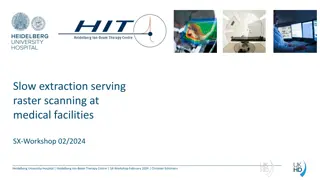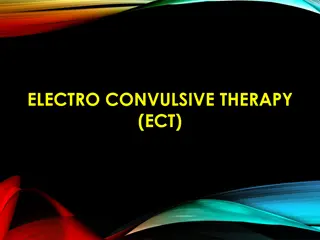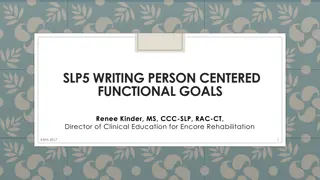Defusion Techniques in Therapy
Exploring the challenges of integrating defusion techniques seamlessly in therapy and describing the rationale behind their use. Defusion strategies disrupt conventional language rules to alter experiences and reduce reliance on language as the ultimate truth. Parameters around language structure, word usage, tone, and attention highlight how defusion strategies aim to shift focus from the content to the process of thinking and speaking.
Download Presentation

Please find below an Image/Link to download the presentation.
The content on the website is provided AS IS for your information and personal use only. It may not be sold, licensed, or shared on other websites without obtaining consent from the author.If you encounter any issues during the download, it is possible that the publisher has removed the file from their server.
You are allowed to download the files provided on this website for personal or commercial use, subject to the condition that they are used lawfully. All files are the property of their respective owners.
The content on the website is provided AS IS for your information and personal use only. It may not be sold, licensed, or shared on other websites without obtaining consent from the author.
E N D
Presentation Transcript
John T. Blackledge, Ph. D. Morehead State University Kentucky
How many of you have at least some difficulty introducing defusion techniques into therapy in a way that s seamless and not overly odd ? How many of you have at least some difficulty describing the rationale behind why you are using defusion techniques?
Purpose what they say they are. Method language/her own thoughts to disrupt language s ability to change experience in problematic ways. Why use? barriers to effective movement toward personally meaningful values and goals: To facilitate acceptance To help client unhook from unhelpful verbal rules Purpose: See thoughts as what they are, not as Method: Change the way the client experiences Why use?: When thoughts are functioning as
Defusion strategies break the rules of language as usual to: Disrupt its ability to change your experience Help undercut reliance on language as the final arbiter of Truth .
Think of all the conditions virtually always present when language is being spoken with meaning and listened to with understanding: Parameters exist around how sentences are structured and how words are used. Certain words refer to certain things. Certain minimal grammatical units must be used.
Parameters exist around how quickly words can be spoken & how frequently a word can be repeated. Tone of voice/style of speech must reasonably match content in order for words to function as expected.
Parameters exist around what is attended to when thinking or speaking: You attend to the content of what s being thought or spoken about rather than the process of thinking, hearing, or speaking Once you focus on the process of thinking or speaking, you lose the flow you begin to focus on the fact that words or thoughts are being formed, rather than on the content of what is being formed.
The Mind: Treat the mind as an external event; almost as a separate person. Mental appreciation: Thank your mind; show aesthetic appreciation for its products. I m having the thought that : Might include category labels in descriptions/evaluations of private events.
Word repetition (e.g., milk exercise) Speaking very slowly Even disrupting cadence of speech Description vs. evaluation Singing thought/speaking thought in odd voice
Just noticing: Use the language of observation (e.g., noticing) when talking about thoughts. Buying thoughts: Use active language to distinguish thoughts and beliefs. Carry your keys: Assign difficult thoughts and experiences to the clients keys. Ask the client to think the thought as a thought each time the keys are handled, and then carry them from there
Writing thoughts/emotions on paper Put them out there: Sit next to the client and put each thought and experience out in front of you both as an object. Open mindfulness: Watching thoughts as external objects. Focused mindfulness: Direct attention to nonliteral dimensions of experience.
Often not a matter of targeting a particular thought for defusion . Repeatedly creating a context in therapy where thoughts are viewed from a different perspective in different ways Seeding in mind and thought talk regularly, session by session Catching times when client is fused with unhelpful/distressing thoughts, and using one of many defusion techniques
Invalidating the client Light use (like what we ll practice in a minute) doesn t tend to do this. Make sure the client knows you get it and you care before moving into heavier use/more invasive techniques Freaking out the client Setting up the general notion that language is fraudulent can be awkward The first two techniques we practice will hopefully help with this If done clumsily, can come off as weird (in a non- therapeutic way)
[Precede with Cognitive DefusionBeginning Defusion 5:50->] Look for examples of therapist using mind and thought talk.
Break into pairs Roleplay therapist and client. Therapist makes consistent use of simple thought / mind defusion statements like .. You re having a lot of thoughts about .. , What other thoughts are showing up? , What else is your mind saying about ..? , you re having the thought that . Be mindful of infusing sufficient empathy into the interaction. We ll roleplay for 5 minutes, then break and discuss as pairs, then as a group. Then, you ll switch roles and repeat.
Example Prompting the client to recall a time when he/she believed something and later found out it wasn t true: Can you remember a time when you were anxious or afraid, and had some pretty convincing thoughts about bad things that were going to happen to you .and then those thoughts turned out not to be true? Yeah ..Minds are good at throwing thoughts like that at us. So good that sometimes those thoughts fly under the radar and we never suspect we ve been taken for a ride. I wonder do you think it s possible some of the thoughts you re having now could be like that?
Demonstrate Description-Evaluation technique roleplay with volunteer anxious client . Break into pairs and practice technique (10 minutes) discuss as pair, discuss as group, switch roles and repeat.
1. Ask client to provide examples of descriptions, then evaluations, of an object. Write them down & label them. 2. Ask client if the evaluations seem as solid , as etched in stone as the descriptions. Ask them if the evaluations feel fishy ? 3. Go through the same procedure with an emotion the client is feeling now. 4. Acknowledge that it s hard to see the distinction when the emotion is intense. But when you step back from it now are those evaluations as solid (etc.) as these descriptions?
ACT in ActionMindfulness, self, etc. 1:07:30 Slowing down ..changing cadence of speech Pair up Client discusses emotionally-charged issue (e.g., recounts distressing event that links back to central focus in therapy) in a somewhat rapid manner. Therapist jumps in as above. 10 minutes, discuss as pair, then discuss as group.
Spotting client fusion/defusion: Cognitive Defusion-Additional Defusion Techniques 1:10:38-1:16:00 Get into small groups Stop disc when client fused/not fused with difficult thoughts Discuss verbal/nonverbal signs of each Each member of group generates a different defusion technique to address that thought. Discuss as small group after each person s turn?
Learning ACTCognitive Defusion17:50- Get into small groups Stop disc when client fused/not fused with difficult thoughts Discuss verbal/nonverbal signs of each Each member of group generates a different defusion technique to address that thought. Discuss as small group after each person s turn?























